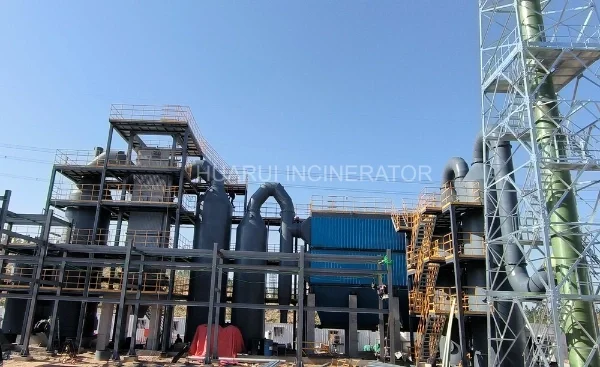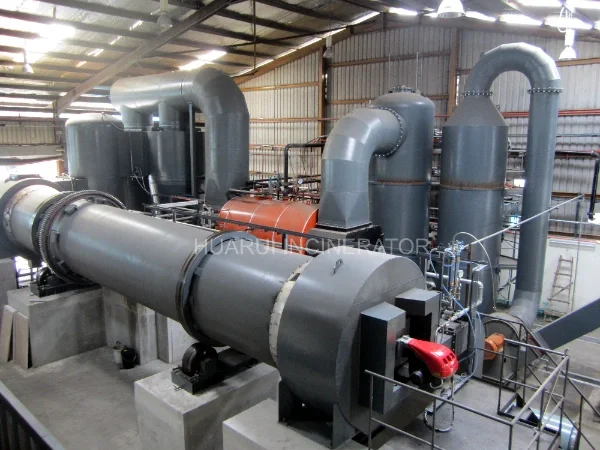
Clear records
history record
News
Revolutionizing Waste Management: Exploring the Efficiency of Industrial Waste Rotary Kiln Incinerators
Introduction to Waste Management
Welcome to the world of waste management, where efficiency and sustainability are becoming increasingly vital. As our planet faces unprecedented challenges in dealing with industrial waste, innovative solutions are emerging to revolutionize the way we dispose of it. One such solution is the Industrial Waste Rotary Kiln Incinerator – a cutting-edge technology that promises efficient and eco-friendly waste disposal like never before! In this blog post, we will delve into the fascinating world of these incinerators, exploring their advantages, eco-friendly features, considerations for implementation, and more. So fasten your seatbelts as we embark on a journey to discover how industrial waste rotary kiln incinerators are transforming the face of waste management!
The Need for Efficient Waste Disposal Solutions
In today's world, waste management is a pressing issue that demands our attention. As industrialization continues to grow, so does the amount of waste generated by various industries. This waste can be hazardous and pose serious risks to both human health and the environment if not properly disposed of.
Traditional methods of waste disposal such as landfilling or open burning are no longer viable options due to their negative impact on air, water, and soil quality. As a result, there is an urgent need for efficient waste disposal solutions that minimize these harmful effects.
One solution that has been gaining traction in recent years is the use of industrial waste rotary kiln incinerators. These innovative incinerators provide a more sustainable way to dispose of industrial waste by converting it into inert ash through high-temperature combustion.
By utilizing this technology, industries can significantly reduce their carbon footprint while effectively managing their waste streams. The efficiency of these incinerators ensures complete combustion and reduces emissions of pollutants such as greenhouse gases and toxic substances.
Moreover, industrial waste rotary kiln incinerators offer several advantages over traditional methods. They have a higher capacity for handling large volumes of waste, making them suitable for industries with high production rates. Additionally, they have a smaller physical footprint compared to landfills and allow for better resource recovery through energy generation from the combustion process.
Implementing industrial waste rotary kiln incinerators requires careful consideration of factors such as regulatory compliance, cost-effectiveness, and potential environmental impacts. Adequate training and expertise are essential to ensure safe operation and adherence to strict emission standards.
Efficient waste disposal solutions are crucial in addressing the growing problem of industrial waste management. Industrial Waste Rotary Kiln Incinerators offer numerous benefits in terms of sustainability, reduced emissions, and improved resource recovery.

What is a Industrial Waste Rotary Kiln Incinerator?
When it comes to waste management solutions, one of the most efficient and effective methods for disposing of industrial waste is through the use of rotary kiln incinerators. But what exactly is an industrial waste rotary kiln incinerator?
A rotary kiln incinerator is a specialized piece of equipment designed to safely burn various types of waste materials at high temperatures. It consists of a cylindrical drum, known as the kiln, which rotates slowly and allows for thorough combustion and destruction of the waste.
Inside the kiln, the waste material is subjected to intense heat generated by either direct or indirect firing methods. This heat causes chemical reactions that break down organic compounds into harmless gases and ash.
The design and operation of these incinerators ensure maximum efficiency in terms of both energy consumption and waste elimination. They are capable of handling large volumes of industrial waste while minimizing emissions and environmental impact.
Furthermore, rotary kiln incinerators can handle a wide range of waste materials including hazardous substances such as chemicals, pharmaceuticals, medical wastes, and even organic sludge from wastewater treatment plants.
In addition to their exceptional capability for destroying harmful substances, these incinerators also offer other advantages such as minimal maintenance requirements, compact size that saves space in industrial facilities, and flexibility in terms of fuel options.
Advantages of Industrial Waste Rotary Kiln Incinerators
When it comes to waste management, industrial waste rotary kiln incinerators offer a range of advantages that make them an efficient and effective solution.
One key advantage is their ability to handle a wide variety of waste types. These incinerators can effectively dispose of hazardous and non-hazardous solid wastes, sludges, liquids, and even gases. This versatility makes them suitable for use in various industries such as chemical plants, pharmaceutical companies, and manufacturing facilities.
Another advantage is the high temperature combustion process that takes place within the rotary kiln incinerator. The intense heat created by the combustion chamber ensures thorough destruction of organic compounds and harmful pollutants present in the waste materials. This helps minimize air pollution emissions while also reducing the volume of waste generated.
Furthermore, these incinerators are designed with advanced control systems that allow for precise monitoring and adjustment of the combustion process. This ensures optimal performance at all times while maintaining compliance with environmental regulations.
In addition to their efficiency in waste disposal, industrial waste rotary kiln incinerators also offer economic benefits. They have a relatively low operating cost compared to other methods like landfilling or biological treatment processes. Plus, they may generate energy through heat recovery systems which can be used for various purposes such as steam production or electricity generation.
Industrial waste rotary kiln incinerators provide numerous advantages including versatile waste handling capabilities, efficient pollutant destruction rates, advanced control systems for optimal performance, and potential energy recovery options – making them an attractive choice for revolutionizing modern-day waste management practices.
Eco-Friendly Features and Benefits
When it comes to waste management, one of the key considerations is the environmental impact. This is where industrial waste rotary kiln incinerators truly shine, offering a range of eco-friendly features and benefits.
First and foremost, these incinerators are designed to efficiently burn various types of industrial waste materials. By operating at high temperatures, they effectively break down hazardous substances and reduce their volume significantly. This not only minimizes the need for landfill space but also helps prevent groundwater contamination.
Furthermore, modern incinerator technologies have advanced filtration systems in place to capture harmful emissions before they are released into the atmosphere. These systems remove pollutants such as heavy metals, dioxins, and furans from the exhaust gases. As a result, air pollution is greatly reduced compared to traditional disposal methods like open burning or burial.
In addition to reducing pollution during operation, industrial waste rotary kiln incinerators also offer energy recovery capabilities. The heat generated during the combustion process can be harnessed and used for various purposes such as steam generation or electricity production. This increases overall energy efficiency and reduces reliance on fossil fuels.
Another significant benefit of these incinerators is their ability to handle different types of waste simultaneously. By incorporating multiple chambers within a single unit, they can accommodate diverse materials without compromising performance or safety standards.
With their efficient combustion processes and advanced emission control mechanisms, industrial waste rotary kiln incinerators provide an environmentally friendly solution for effective waste management in industries across various sectors.

Considerations for Implementation
When it comes to implementing industrial waste rotary kiln incinerators, there are several important factors that need to be taken into consideration. First and foremost is the location of the incinerator. It should be strategically placed in an area where it can effectively handle the volume of waste generated by nearby industries.
Another key consideration is the size and capacity of the incinerator. It should be able to accommodate the amount of waste produced on a daily basis without causing any disruptions or delays in the disposal process.
Safety measures are also crucial when implementing these incinerators. Adequate measures must be put in place to ensure that workers are protected from harmful emissions and potential accidents during operation.
Furthermore, proper training and education for staff members involved in operating and maintaining the incinerator is essential. They should have a thorough understanding of safety protocols, as well as knowledge about how to efficiently operate and monitor the equipment.
Additionally, compliance with local regulations and permits is imperative when implementing an industrial waste rotary kiln incinerator. This ensures that all legal requirements are met, preventing any potential issues or penalties down the line.
Ongoing monitoring and maintenance play a vital role in successful implementation. Regular inspections, troubleshooting procedures, and routine maintenance checks help ensure optimal performance and prevent any unexpected breakdowns or malfunctions.
By considering these various factors during implementation, businesses can maximize efficiency while minimizing environmental impact when utilizing industrial waste rotary kiln incinerators.
Conclusion
In today's rapidly evolving world, waste management has become a critical issue that requires efficient and sustainable solutions. Industrial waste rotary kiln incinerators have emerged as a game-changer in the field of waste disposal, revolutionizing the way we handle industrial waste.
These incinerators offer numerous advantages over traditional methods of waste disposal. They are highly efficient in terms of energy consumption and can effectively reduce the volume and toxicity of industrial waste. By converting solid waste into ash, gases, and heat, these incinerators enable industries to minimize their environmental footprint while complying with strict regulations.
One of the key benefits of industrial waste rotary kiln incinerators is their eco-friendly nature. These systems are designed to meet stringent emission standards by incorporating advanced technologies such as flue gas cleaning systems and pollution control devices. This ensures that harmful pollutants are minimized or eliminated before being released into the atmosphere.
Implementing an industrial waste rotary kiln incinerator requires careful consideration of various factors such as site selection, permits, operational costs, maintenance requirements, and community acceptance. However, when properly planned and executed, these systems can significantly enhance overall efficiency in waste management processes.
Industrial Waste Rotary Kiln Incinerators have proven to be a reliable solution for efficient and sustainable waste disposal in industries worldwide. With their numerous advantages including energy efficiency, reduced environmental impact, and compliance with regulations; these incinerators play a crucial role in transforming how we manage industrial waste.
By embracing this innovative technology alongside other environmentally friendly practices like recycling and reducing wastage at its source; businesses can contribute towards creating cleaner communities while maximizing resource utilization.
Related news






